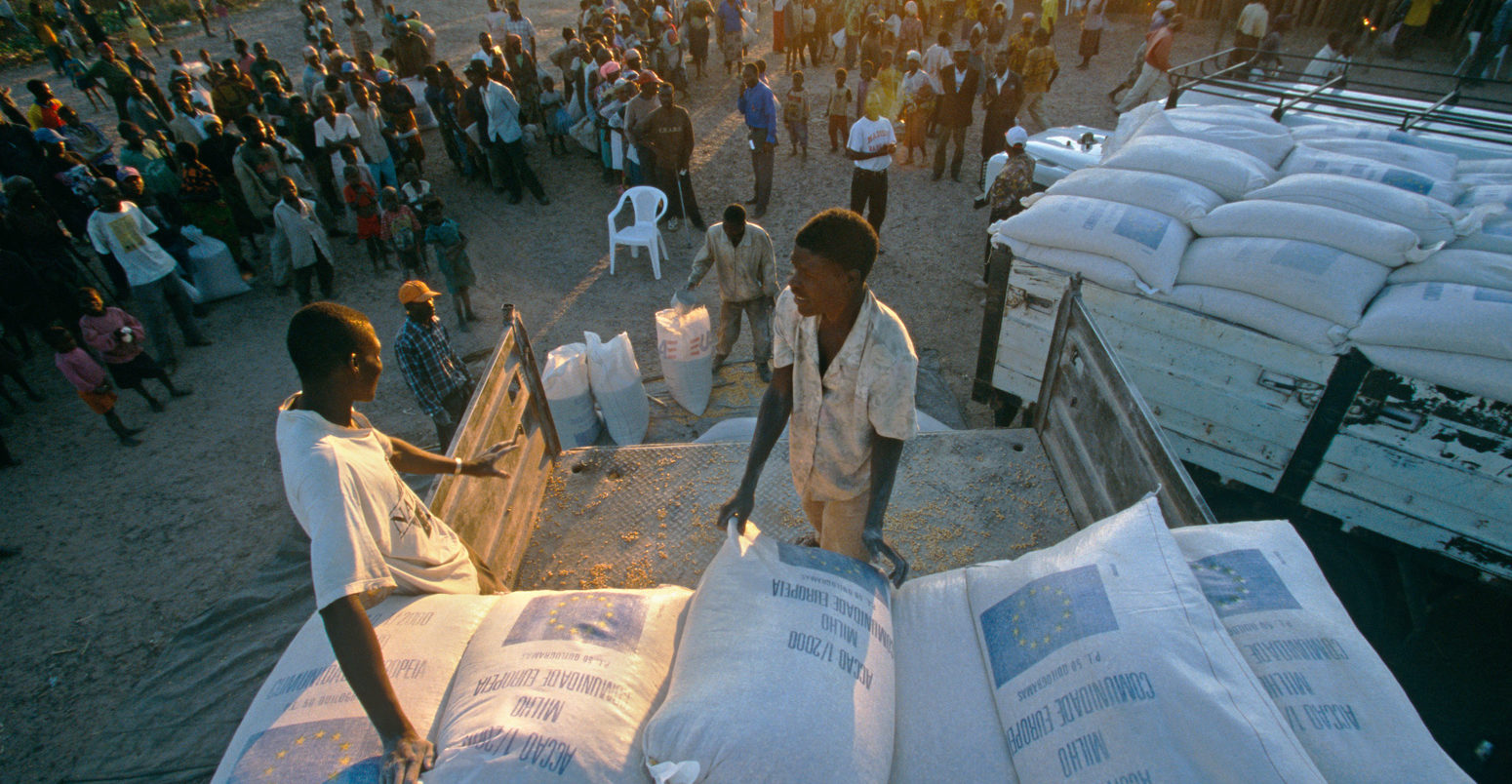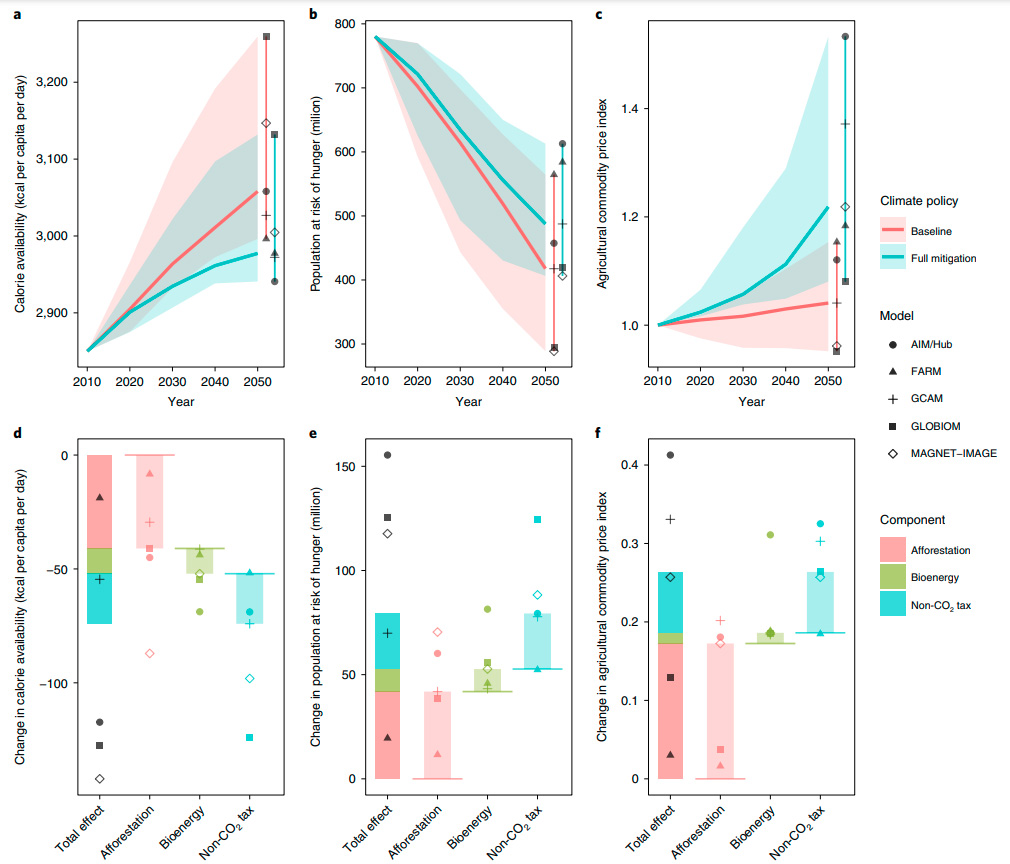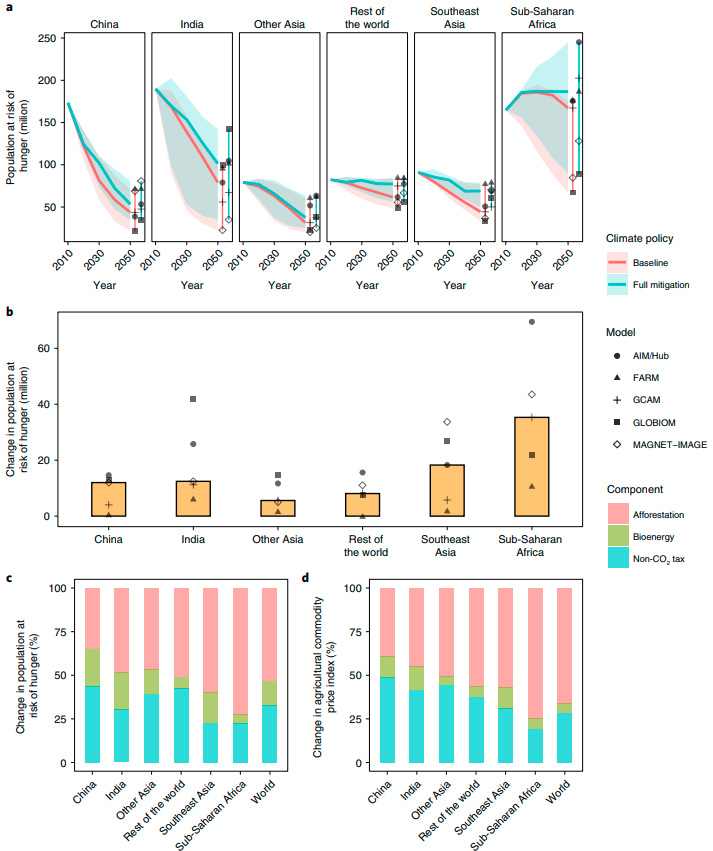
Using land to tackle climate change could have ‘adverse impacts’ on global hunger
Giuliana Viglione
02.24.22Giuliana Viglione
24.02.2022 | 4:00pmRelying heavily on land use to tackle climate change could slow the decline in global hunger, according to new research published in Nature Food.
Researchers examine how three different types of land-based mitigation strategies – tree planting, growing bioenergy crops and reducing non-CO2 agricultural emissions – could affect prices of agricultural commodities in the coming decades. They then estimated how many people would be at risk of hunger due to rising food prices.
Although global hunger is projected to continue to decline, they find that all three mitigation methods have the potential to increase the global population at risk of hunger, compared to a baseline scenario matching the world’s current trajectory. Widespread tree-planting policies alone could put more than 40 million people at risk, the study suggests.
However, one researcher who was not involved with the study points out that the model does not incorporate the potential effects of climate change on future food security. Climate variability and extremes are already a major contributor to increasing global food insecurity.
The lead author of the study stresses that their model is “quite simplified”, but notes that the findings suggest caution and thoughtfulness in how mitigation strategies are implemented.
Mitigation methods
The agriculture, forestry and land-use sector is a major component of humanity’s greenhouse gas emissions. For example, food systems – a term which encompasses the production, processing, transportation and consumption of food – are estimated to be responsible for about one-third of annual emissions.
At the same time, many climate change mitigation measures require significant land use, which can increase the competition for agriculturally productive land and drive up costs for farmers. For example, many types of nature-based solutions to climate change require preserving ecosystems from human use or restoring degraded land.
The researchers focus their study on three land-based mitigation measures: afforestation, bioenergy crops and cutting non-CO2 greenhouse gas emissions – such as methane and nitrous oxides. They use a mitigation strategy consistent with RCP2.6 – an emissions scenario in which global warming stays below 2C above pre-industrial levels.
Afforestation – or tree-planting – has been a key component of many countries’ plans to reach “net-zero” emissions by mid-century, but will require large amounts of land in order to sequester carbon – around 1m hectares in the UK alone by 2050. Afforestation is represented in the study by imposing a carbon price on the carbon stored in forests.
As with afforestation, planting bioenergy crops will directly compete with agriculture for productive land. But bioenergy, especially in combination with carbon capture and storage (BECCS), is often seen as an important pathway towards decarbonisation. BECCS is characterised in the study by calculating the bioenergy demand of decarbonisation.
Reducing non-CO2 emissions can directly impact food prices by increasing production costs if new technologies are adopted. Similarly, carbon pricing schemes can drive up food prices, since non-CO2 emissions from agriculture cannot be completely eliminated. These are represented in the study as a tax on non-CO2 emissions.
Output and emissions
Using a suite of six agro-economic models and integrated assessment models (IAMs), the researchers analyse how the combined mitigation measures will affect agricultural output and emissions, as well as the distribution of land use between agriculture, bioenergy and afforestation.
In addition to outputting land-use distribution and agricultural production, the models provide an agricultural price index and calorific intake per capita on a national level. The researchers take these outputs and combine them in a model that calculates what proportion of a total population is at risk of hunger in any given year.
By “turning off” each mitigation method in turn, the researchers also determine how much of an influence each individual strategy has on the final result.
Global hunger has been generally declining over the past five decades. Although it has increased in recent years, in part due to the Covid-19 pandemic, it is projected to continue to decline in the coming decades as global per-capita income continues to increase.
However, the study finds that if these land-based mitigation policies were implemented, hunger would decline less than it is currently projected to under a baseline scenario matching the world’s current trajectory – putting an extra 79.4 million people at risk of hunger in the year 2050.
The majority of this risk – 41.9 million people – is due to the knock-on effects of afforestation, with 26.7 million people at increased risk due to non-CO2 abatement measures and 10.8 million people due to increased bioenergy production. The researchers also model the price increases due to each of the mitigation measures, finding increases of 17.2% from afforestation, 7.8% from non-CO2 abatement and 1.4% from bioenergy production.
The charts below show how the combined mitigation strategies will change calorie availability, at-risk population and agricultural prices as compared to a baseline policy (top row) and how each specific policy affects those three quantities (bottom). The pink lines show the baseline scenario, while the blue lines show the full mitigation strategy. In the lower panels, pink is the contribution of afforestation, green is the contribution of bioenergy production and blue is the contribution of a non-CO2 emissions tax.

Even though bioenergy and afforestation both compete with agriculture for suitable land, afforestation has a much larger influence on future food pricing and calorie availability. Dr Shinichiro Fujimori, an environmental engineer and climate scientist at Kyoto University, tells Carbon Brief:
“I was really shocked by the result.”
Fujimori, who led the new work, says he originally thought that BECCS would be the main driver of declining food security. However, it turned out to have the least effect of the three mitigation measures they studied. This may be due to the different mechanisms by which afforestation and BECCS influence prices in their models, he says. The effects of afforestation are created by carbon pricing, which incentivises tree planting and drives up land rents. But the effects from bioenergy are driven by energy demand, which is limited by population growth and societal development.
Addressing the impacts of mitigation approaches on food security is a “very unique” approach, says Dr Luis Peña-Lévano, an agricultural economist at the University of Wisconsin-River Falls. Previous work in the field has looked at the impacts of mitigation on agricultural markets, but not necessarily taken the extra step to analyse how those changes will affect hunger, he says.
Peña-Lévano, who was not involved in the study, tells Carbon Brief that the study is “very holistic” in trying to understand the interplay between the agroeconomic models and models of food security.
‘Careful interpretation’ required
Using the IAMs also allowed the researchers to probe how countries and regions of the world would be differentially impacted by climate change mitigation efforts.
Sub-Saharan Africa, which is projected to have increased hunger risk until at least 2030 even in the baseline scenario, would be hit hardest by the potential impacts of land-based mitigation. The researchers find that more than 35 million more people in the region would be put at risk of hunger by 2050 under their mitigation measures.
Around the world, agricultural prices are influenced differently by the three studied mitigation measures, due to differences in diet, food production, land rent and other factors. For example, diets in Asia typically contain a higher proportion of rice than in other regions. Since rice production has very high associated methane emissions, rice-producing and -consuming countries would be more strongly affected by taxes on non-CO2 emissions.
The charts below show how the population at risk of hunger would change due to the selected climate mitigation strategies in different parts of the world, and how each strategy would contribute to the hunger risk in each country or region.
The top panels compare the baseline scenario (pink) to the full mitigation scenario (blue) for 2010-50. The middle panel shows the number of excess people at risk in 2050 in various regions. The lower panels attribute the changes in at-risk population and agricultural prices to afforestation (pink), bioenergy (green) and non-CO2 tax (blue).

The researchers also compared the results under three different shared socioeconomic pathways (SSPs), which describe different ways in which societies and economies could develop over the century.
The bulk of the study focuses on SSP2, the “middle of the road” scenario. However, they also consider SSP1, which has low global population growth and high economic development, and SSP3, which has high population growth and low economic development.
The higher economic growth in SSP1 means that baseline hunger in that scenario declines faster than in SSP2; by contrast, in the SSP3 simulations, baseline hunger remains relatively constant through 2050. Under SSP1, the number of people at risk of hunger by mid-century is projected to increase by 61.1 million as compared to the baseline; under SSP3 this number is nearly 360 million people.
All three SSPs studied show similar trends in terms of which measures would have the greatest impact on food prices, calorific intake and hunger risk: afforestation, followed by taxes on non-CO2 emissions, with bioenergy production a distant third.
Overall, the results of the study are “both consistent with the literature and are very logical”, Peña-Lévano says. However, he adds, “they did not take into account climate change impacts on the system” – for example, how unmitigated climate change will impact future crop yields. Numerous studies have shown how climate change will impact suitable growing areas, increase the threat of plant diseases, degrade cropland quality and increase food insecurity.
In similar research that Peña-Lévano has carried out looking specifically at mitigation by afforestation strategies, implementing climate change impacts into the models causes major shifts in the viability of the strategy, he says. Once climate-related food price shocks – such as those caused by extreme weather events – were incorporated into Peña-Lévano’s model, it was no longer economically or socially viable to dedicate so much land to afforestation, he says.
However, Fujimori says that their choice to exclude climate change impacts is justified. In a 2018 paper that he and his colleagues published in Nature Climate Change, they found that under RCP2.6, the effects of climate change impacts on crops were much smaller than the effects of mitigation. Disregarding the climate change impacts also allowed them to better assess the impacts of the individual mitigation measures, he adds.
The authors stress that the relationships between hunger and poverty are “complex”, and thus it is difficult to determine exactly how changes in agricultural prices will affect global hunger. They note that their results “require careful interpretation” but say that it is worth considering how mitigation measures might impact food security.
Fujimori tells Carbon Brief:
“How we represent the climate change mitigation actions is quite simplified in our modelling exercise. Therefore, I would not like the readers of my paper to interpret this study as ‘we shouldn’t do climate actions in agriculture or in land-use sectors’. Definitely, those sectors are important…However, we need to be very careful in how we implement the climate mitigation measures in those areas.”
People “do not like to see the adverse side effects of climate change mitigation”, Fujimori says. He tells Carbon Brief:
“There are many, many studies supporting climate action. Climate change impacts will be large and mitigation will definitely be needed.”
However, he adds, it is important to give “careful consideration” to the ways that mitigation measures, too, can impact vulnerable populations.
Fujimori, S. et al. (2022) Land-based climate change mitigation measures can affect agricultural markets and food security, Nature Food, doi: 10.1038/s43016-022-00464-4.
-
Using land to tackle climate change could have ‘adverse impacts’ on global hunger

